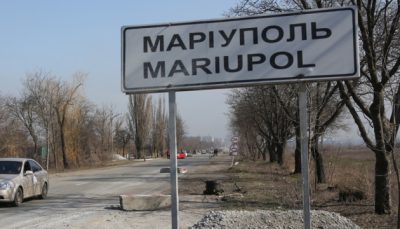Battle for Mariupol Is Ending

All Global Research articles can be read in 51 languages by activating the “Translate Website” drop down menu on the top banner of our home page (Desktop version).
To receive Global Research’s Daily Newsletter (selected articles), click here.
Visit and follow us on Instagram, Twitter and Facebook. Feel free to repost and share widely Global Research articles.
***
The Russian Ministry of Defence offer of surrender terms to the personnel of the extreme nationalist neo-Nazi battalions and foreign mercenaries in the Azovstal iron and steel works to end hostilities by 1.00 pm Moscow time on Sunday would only have been a proforma gesture.
Moscow’s statement said, that radio interceptions at Azovstal — as many as 367 in the past twenty-four hours — showed that the militants were in a hopeless situation, practically without food and water, and were seeking permission to lay down arms and surrender but “the Kiev authorities categorically forbid them to do this.”
Yesterday, Denis Pushilin, Head of the Donetsk administration, openly called for “elimination” of the neo-Nazi militants holed up in Azovstal.
Azovstal is a massive Soviet-era plant, a city within the city of Mariupol. There is an underground city beneath the plant built in the Soviet era which includes Cold-War realities — structures to withstand bombing, blockades, and even nuclear strike. The Russian estimation is that a maximum of 2500 people could be holding out in the underground city equipped with armoured vehicles and huge arsenal of weapons and ammunition.
The Russian side is in some hurry to finish off the operation in Mariupol. The forces there are are urgently needed to be redeployed to the Donbass front. Kiev, on the other hand, is banking on delaying the Russian operation which gives it more time to reinforce its forces in Donbass.
President Zelensky has once again switched tack to speak about the diplomatic track. His latest stance is that Ukraine is ready to discuss abandoning its bid to join NATO and the status of Crimea with Russia, but not until Moscow halts hostilities and withdraws its troops!
The Ukrainian armed forces already lost 23,367 people while 1,464 people surrendered in Mariupol as of yesterday and another 2,500 are blocked at the city’s Azovstal plant. As for the Donbass, Russian forces enjoy superiority in numbers, logistics, firepower and terrain and a defeat on that front will leave Zelensky no choice but to seek a negotiated settlement on Russian terms. (See a relatively balanced prognosis by the American military analyst Colonel (Retd.) Daniel Davis, The Battle For Donbas Will Be A Tough Fight For Ukraine.)
Indeed, Zelensky and his American mentors hope that the battle for Donbass is wide open. The point is, although much of the war in eastern Ukraine will be fought in areas of open ground, Russian forces also have to take several significant population centres to achieve their objectives in Donetsk and Luhansk oblasts, including Severodonetsk, Rubizhne, Lysychansk, Slovyansk, and Kramatorsk as well as several smaller towns.
The Russian performance so far does not bode well for rapid success against built-up areas. Again, the weapons provided by the West have helped Ukrainian forces significantly to prevent Russia controlling the skies. The Ukrainian side is counting on these factors to stem the tide of the battle. Plus, of course, their morale is high.
Be that as it may, this time around, there is no confusion in the Russian mind that a peace settlement is round the corner. The Russians are unlikely to allow themselves to be hoodwinked again, when they took Zelensky for his word, trooped into the talks at Istanbul where an agreement was initialled on the basis of which, in an extravagantly emotional gesture of goodwill, they withdrew troops from Kiev and other northern territories, but only to see their interlocutors in Kiev backtrack on the terms of the agreement.
The strange Russian behaviour conveyed misperceptions that the Kremlin might be looking for the exit door. Evidently, that has emboldened the Western powers to embark upon a large-scale rearmament project for Ukraine, including transfer of heavy offensive systems, high-precision ammunition, modern air defence systems, American Stinger missiles, etc. for use in the upcoming new phase of military confrontation.
It is an open secret that military personnel of the NATO countries are deployed alongside the Ukrainian forces under the guise of “foreign volunteers.” The foreign fighters are led by US officers and the whole command of the Ukrainian armed forces is concentrated mainly in the hands of the Americans.
Arguably, the sinking of the warship Moskva fits into this paradigm. Russian analysts estimate that the last week’s missile strike on the Russian flag ship Moskva was actually masterminded and coordinated by the Pentagon. According to the ADS-B Exchange flight tracking site, a US Navy plane with electronic gear was spotted near the village of Zhurilovka in eastern Romania in the vicinity of the stricken ship Moskva (which probably guided the missile attacks.) Read here and here.
The implied message is: ‘Bring ‘em on.’ In military terms, though, the sinking of the ageing warship, 43 years old, may not be a game changer for the Russian operation. Everything now hinges on the offensive in Donbass — and, potentially further Russian operation in Kherson and Odessa without which the NATO will continue to pose acute threat to Russia in the Black Sea region. The NATO is already slouching toward Moldova.
*
Note to readers: Please click the share buttons above or below. Follow us on Instagram, Twitter and Facebook. Feel free to repost and share widely Global Research articles.
Featured image: Russian forces take control of strategic city pf Mariupol (Source: IP)

